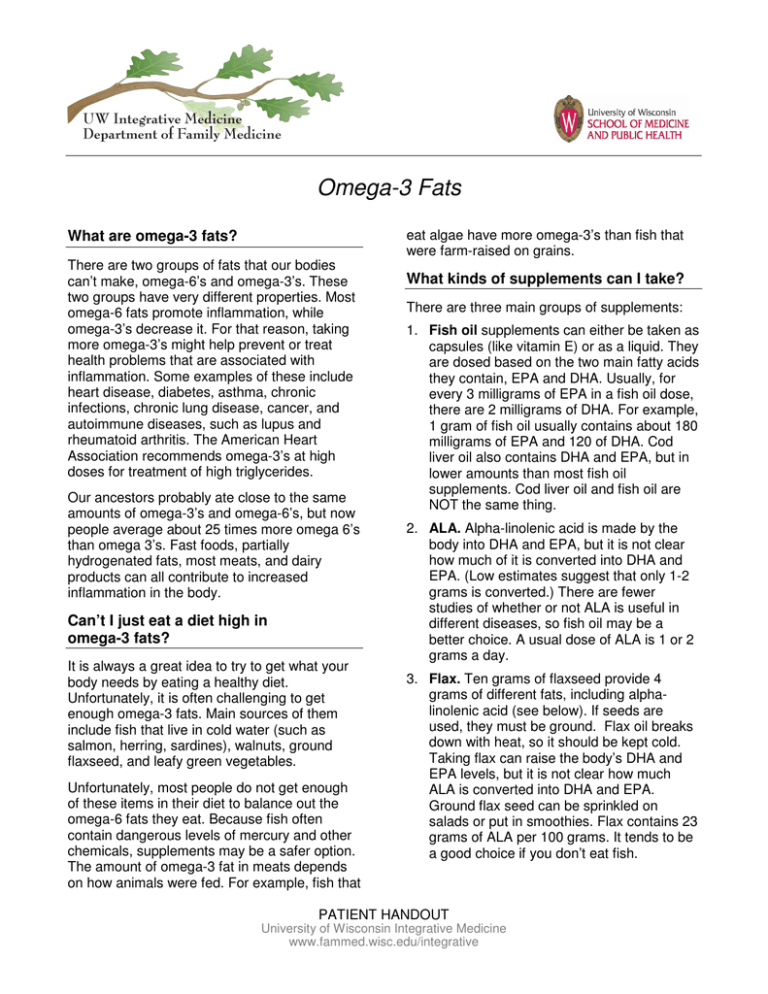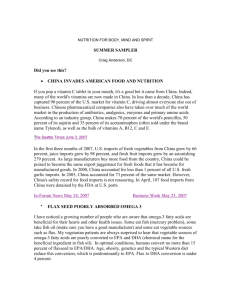What are omega-3 fats?
advertisement

Omega-3 Fats eat algae have more omega-3’s than fish that were farm-raised on grains. What are omega-3 fats? There are two groups of fats that our bodies can’t make, omega-6’s and omega-3’s. These two groups have very different properties. Most omega-6 fats promote inflammation, while omega-3’s decrease it. For that reason, taking more omega-3’s might help prevent or treat health problems that are associated with inflammation. Some examples of these include heart disease, diabetes, asthma, chronic infections, chronic lung disease, cancer, and autoimmune diseases, such as lupus and rheumatoid arthritis. The American Heart Association recommends omega-3’s at high doses for treatment of high triglycerides. Our ancestors probably ate close to the same amounts of omega-3’s and omega-6’s, but now people average about 25 times more omega 6’s than omega 3’s. Fast foods, partially hydrogenated fats, most meats, and dairy products can all contribute to increased inflammation in the body. Can’t I just eat a diet high in omega-3 fats? It is always a great idea to try to get what your body needs by eating a healthy diet. Unfortunately, it is often challenging to get enough omega-3 fats. Main sources of them include fish that live in cold water (such as salmon, herring, sardines), walnuts, ground flaxseed, and leafy green vegetables. Unfortunately, most people do not get enough of these items in their diet to balance out the omega-6 fats they eat. Because fish often contain dangerous levels of mercury and other chemicals, supplements may be a safer option. The amount of omega-3 fat in meats depends on how animals were fed. For example, fish that What kinds of supplements can I take? There are three main groups of supplements: 1. Fish oil supplements can either be taken as capsules (like vitamin E) or as a liquid. They are dosed based on the two main fatty acids they contain, EPA and DHA. Usually, for every 3 milligrams of EPA in a fish oil dose, there are 2 milligrams of DHA. For example, 1 gram of fish oil usually contains about 180 milligrams of EPA and 120 of DHA. Cod liver oil also contains DHA and EPA, but in lower amounts than most fish oil supplements. Cod liver oil and fish oil are NOT the same thing. 2. ALA. Alpha-linolenic acid is made by the body into DHA and EPA, but it is not clear how much of it is converted into DHA and EPA. (Low estimates suggest that only 1-2 grams is converted.) There are fewer studies of whether or not ALA is useful in different diseases, so fish oil may be a better choice. A usual dose of ALA is 1 or 2 grams a day. 3. Flax. Ten grams of flaxseed provide 4 grams of different fats, including alphalinolenic acid (see below). If seeds are used, they must be ground. Flax oil breaks down with heat, so it should be kept cold. Taking flax can raise the body’s DHA and EPA levels, but it is not clear how much ALA is converted into DHA and EPA. Ground flax seed can be sprinkled on salads or put in smoothies. Flax contains 23 grams of ALA per 100 grams. It tends to be a good choice if you don’t eat fish. PATIENT HANDOUT University of Wisconsin Integrative Medicine www.fammed.wisc.edu/integrative Omega-3 Fats What doses of omega-3’s should I take? In research studies, a wide range of doses have been used. A good rule of thumb is to try to get a total of at least 1 gram of DHA and EPA combined. This means taking 3 to 4 grams of fish oil each day. Other sources of omega-3’s tend to contain ALA, which may not be converted to DHA and EPA at high levels. 15-30 ml of flax oil has been used to lower cholesterol numbers. If you want to buy whole flaxseeds, grinding up about 1-2 tablespoons to use on cereal, in smoothies, etc., is a standard dose. Fish and flax oils can sometimes cause indigestion or a bloated feeling, so it can help to take a few small doses each day, instead of one large dose. Storing the oils in the freezer (they won’t freeze) makes them easier to take. Omega 3 Source Flax seed oil Fish body oil Cod liver oil Soy, canola, walnut oils Amount of Omega-3’s in One Gram* 700 mg (in the form of ALA) 300 mg 200 mg (Caution: can lead to high levels of vitamin A intake) 100 mg *Note that non-fish oils (flax, canola, walnut) provide primarily ALA. The benefits of this omega-3 fat are not as well-proven as those of DHA and EPA. Are there any side effects from taking omega-3’s? High doses (more than 5 grams of fish oil a day) may use up the body’s supply of antioxidants. It might be a good idea to take extra vitamin C or E (at the RDA dose) to make up for this. Aside from mild indigestion, these supplements tend to be very safe at the recommended doses. It is a good idea for pregnant women to take omega-3’s as well, since many studies show they decrease problems in pregnancy and can help protect the baby from illness even after birth. Omega-3’s in high doses increase bleeding risk, but this has not proven to be a major problem in doses of 34 grams a day. (The effect is less than the effect of aspirin.) They may lead to hypomania in people with bipolar disorder. They may slow down the immune system at high doses, so immunosuppressed people (with HIV, immune problems) should keep fish oil doses at less than 3 grams a day. Fish oil supplements are, in general, safer than fish meat, as far as being contaminated by mercury, PCB’s and other toxins. Fish meat carries more of these toxins than the oils. When the fish oil is processed, the toxins tend to be filtered out in the processes that remove the ‘fishy odor.’ Most supplements, especially wellrespected national brands, have been found to be toxin-free. How long does it take for omega-3’s to work? Levels of omega-3’s build up quickly in the body once you take supplements, but it may take 6 weeks to 6 months to see a significant change in levels of pain or other symptoms. PATIENT HANDOUT University of Wisconsin Integrative Medicine www.fammed.wisc.edu/integrative 2 Omega-3 Fats The information in this handout is for general education. It is not meant to be used by a patient alone. Please work with your health care practitioner to use this information in the best way possible to promote your health. This handout was created by Adam Rindfleisch, MD, Assistant Professor in the Integrative Medicine Program and the Department of Family Medicine, University of Wisconsin School of Medicine and Public Health. Date created: September, 2007 NOTES PATIENT HANDOUT University of Wisconsin Integrative Medicine www.fammed.wisc.edu/integrative 3




